Types of Wood Siding

When it comes to wood siding for houses, there are many different varieties available. But first things first, what is siding? Siding, also known as wood cladding, is a building material installed on the exterior facade to protect it from damage. Although there are several different materials suitable for the job, such as cement, bricks, metal, or vinyl, wood cladding options are the most popular choice due to their natural appearance and relatively fair costs. In this guide, we’ll review many different wood types to help you select the best option for you.
- Charred Wood
- Pine fir
- Spruce
- Siberian larch
- Oak
- Redwood
- Ash
- Cedar
- Firwood
- Accoya
- Cypress
- Engineered wood
- Thermowood
- Cumaru
- Douglas fir
- Garapa
- Tatajuba
- Massaranduba
- Iroko
Charred Wood
Charred wood (Shou Sugi Ban), also known as burnt wood, is one of the most highly sought-after wood siding types available. The charring process entails applying an open flame to a wood plank to create a slight char along the board’s surface without weakening it. This char weatherproofs the plank and keeps insects away, which is an essential feature for new and old homes.
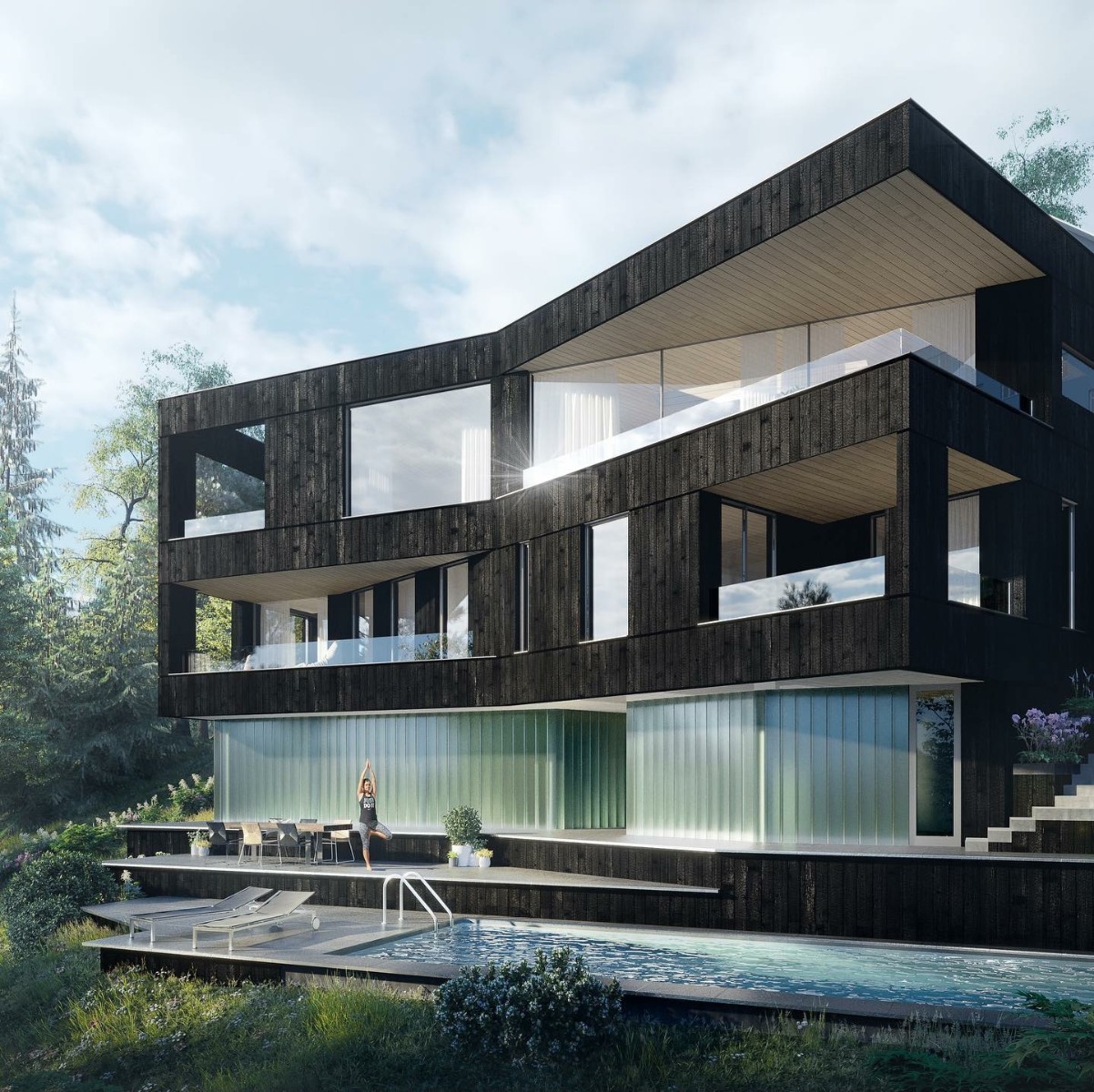
Pros
There are many benefits to choosing charred wood, especially Shou Sugi Ban. You can expect the cladding to last more than 80 years when properly maintained. Adding an oil finish also works with the charred exterior to make it mold and water-resistant.
Cons
Aside from being a little difficult to pronounce, there are really no cons here. Shou Sugi Ban is durable, insect and termite-resistant, and comes in various colors and finishes to match your home aesthetic.
Pine Fir
Pine fir is one of the most common types of wood siding available. Because pine fir is a softwood, it’s generally less expensive and easier to access than other wood species.
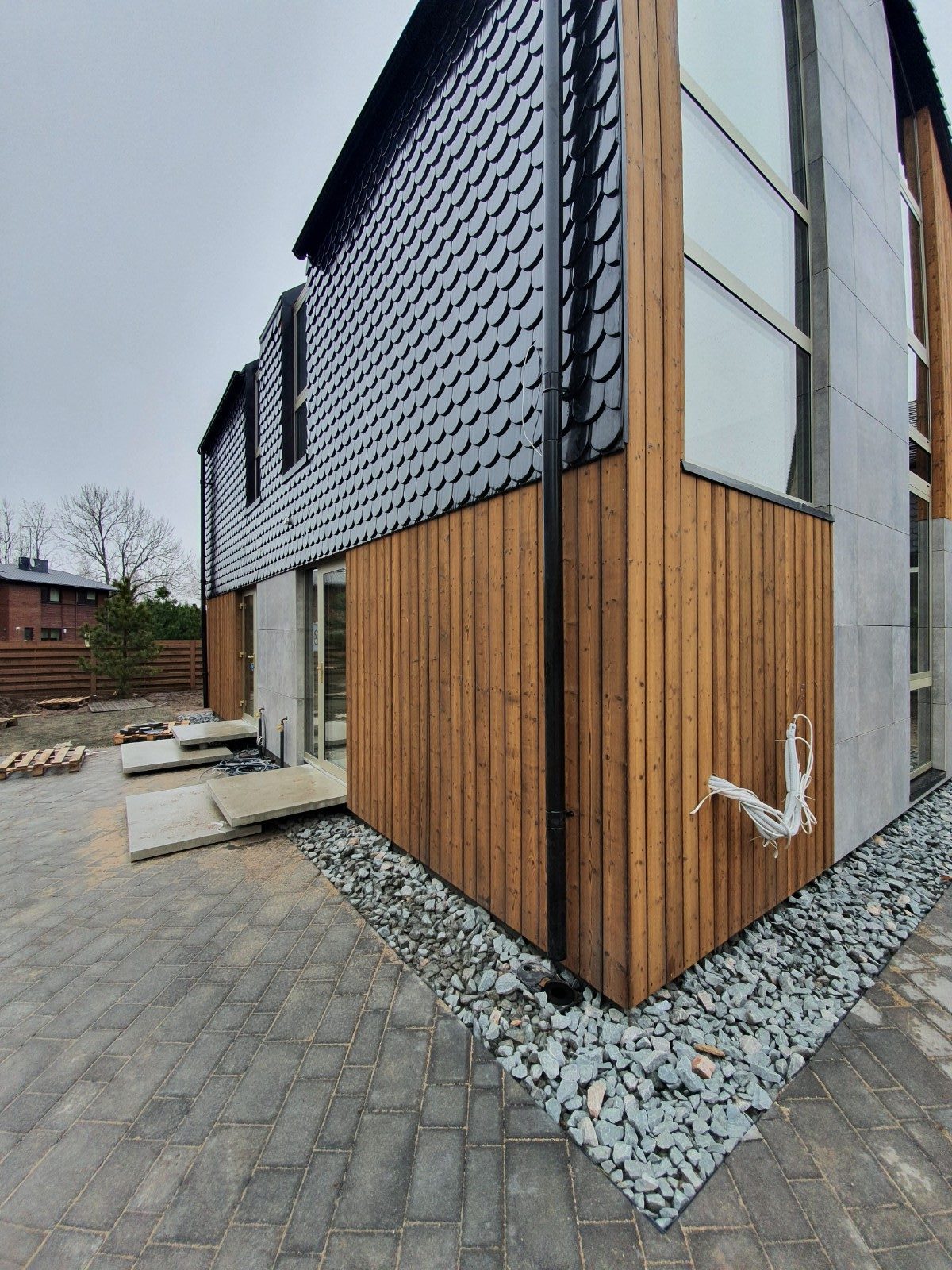
Pros
The price point of pine makes it a fantastic option for beginners looking to remodel their homes. It’s generally less expensive to produce, which means it’s less costly to buy. It also is a great option to create a wood lap finish on the exterior of a home. It is easy to paint and stain and often results in a smooth finish.
Cons
Some varieties of pine fir can be challenging to work with. Adding exterior wood cladding on houses often requires long pieces of wood. Pine fir comes in different lengths, but a vast majority are too short to cover most walls with a single plank adequately. Since it is a softwood, it is also not very resistant to the elements. This means that it has to be well-sealed and maintained to keep out moisture and prevent decay.
Spruce
Spruce is another type of softwood that belongs to the pine family. It is commonly found on the East Coast of the United States.
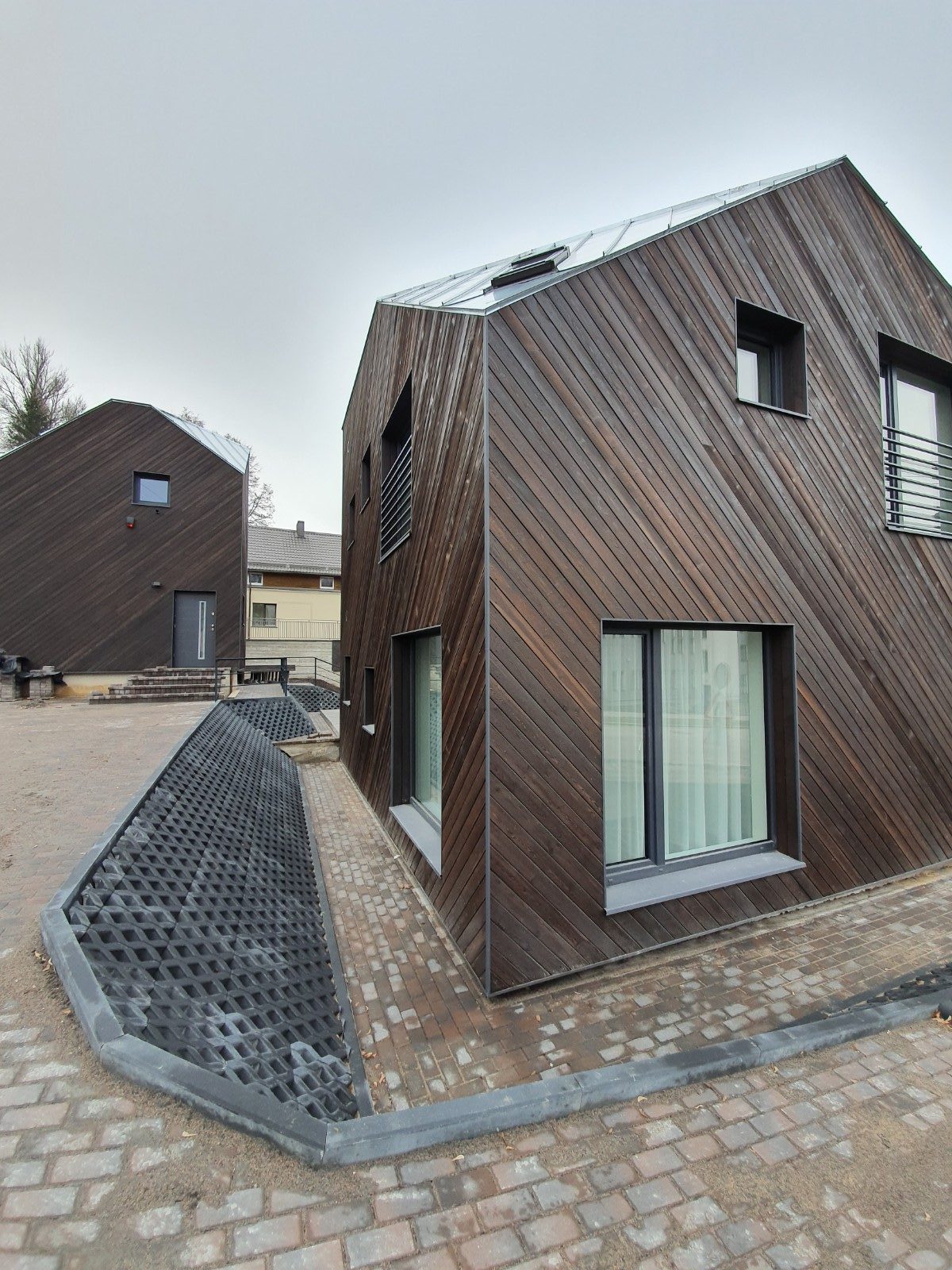
Pros
Because they come from the same family, spruce wood has similar advantages to pine wood. For those looking for a smooth pine finish but in longer lengths, spruce is the best option for clapboards and board siding.
Cons
Spruce wood does not hold up well against moisture. This means that it requires frequent maintenance to protect it from rot, which is time-consuming and costly over time.
Siberian Larch
Siberian Larch is a popular wood cladding style that can be hard to find. This species of wood is stable and holds up well against decay.
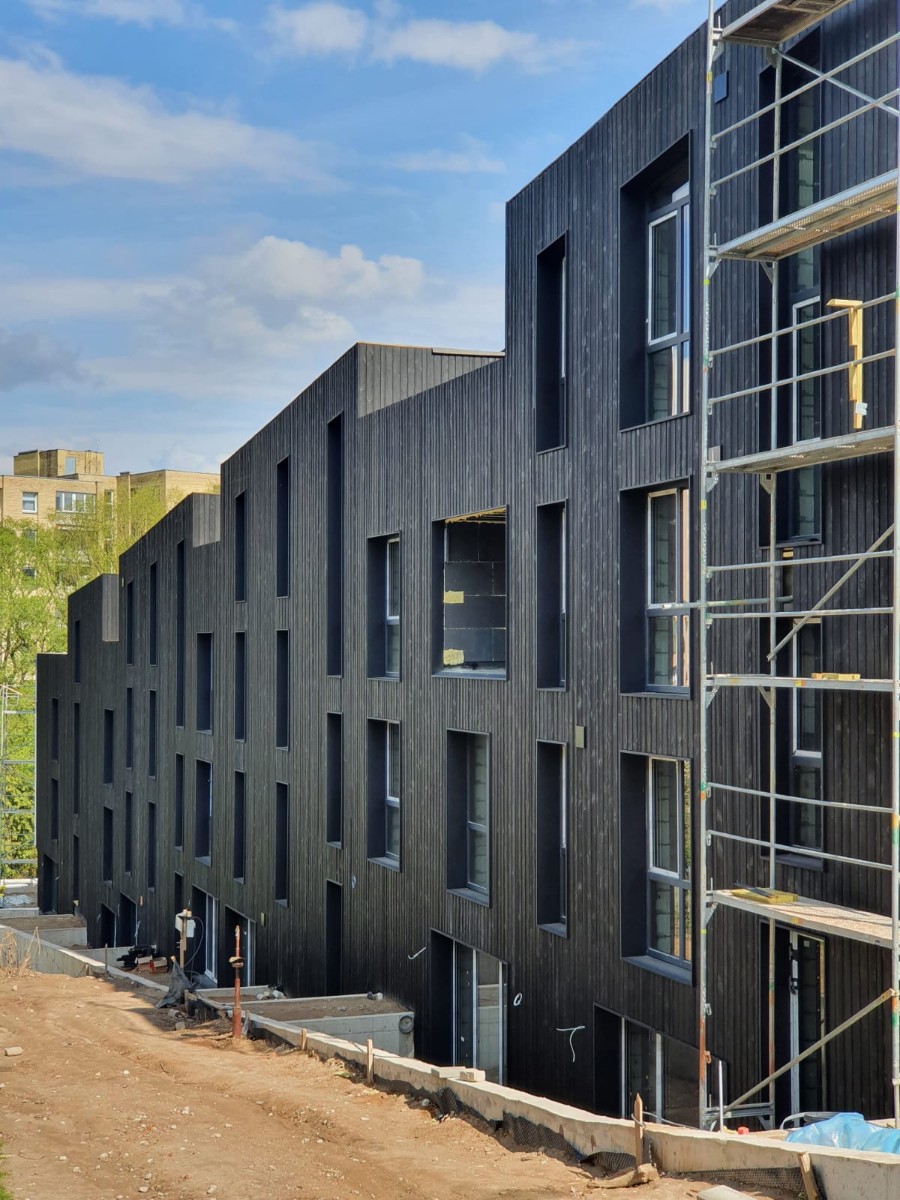
Pros
Due to its high density, Siberian Larch is a stable wood that is naturally resistant to decay. This feature makes it a fantastic choice for wetter climates. It also has a smooth finish and is an excellent choice for adding a more natural aesthetic to your home.
Cons
Siberian Larch can be expensive, especially in comparison to cheaper wood species, like pine and spruce.
Oak
There are many different types of oak available. The most common types are red and white, and both have various applications.
Pros
Few wood types provide as beautiful a finish as oak wood. Its luxurious exterior makes it a popular choice for many. The color and general appearance of oak wood are some of the main reasons it’s so popular today.
Cons
Oakwood cladding for houses tends to add a lot of weight to a structure, which is not always beneficial to DIY projects. Oak is also not a great option as an exterior wood because it quickly fades color when exposed to direct sunlight. Red oak is very porous and should be limited to indoor applications. Even doors made out of dense, white oak, usually have to be replaced within five years.
Redwood
If you are looking for a beautiful amber red exterior, you should consider the redwood variety. It is popular for various indoor and outdoor applications.
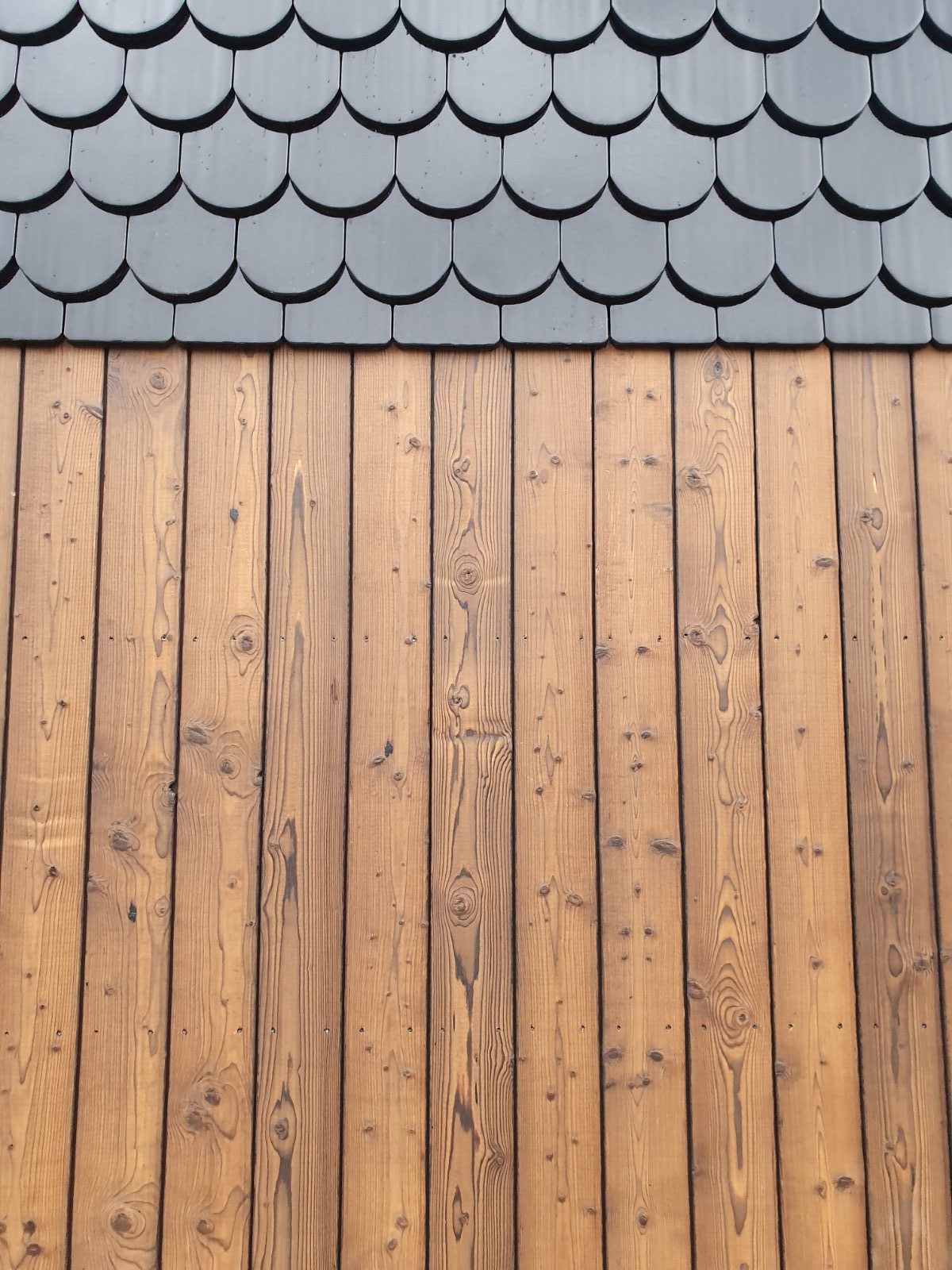
– Shou Sugi Ban light wood planks.
Pros
Redwood resists shrinking and holds up to all elements with minimal warping or cupping, making it a fantastic choice for any climate. It also has little pitch or resin, which means that stains and finishes require less maintenance and maintain their color longer. Although charred wood is known to keep insects at bay, redwood is naturally insect-repellant, especially useful in wooded areas. It is also hard to find wood that matches its deep, textured color anywhere else.
Cons
Although it’s readily available along the West Coast of the United States, redwood can be challenging to obtain and purchase in other areas. Due to its popularity, it is costlier than other species.
Ash
Although some people may not be familiar with ashwood, they’ve probably used it at one point or another. Ashwood is traditionally used to manufacture garden equipment, like rakes and shovels, and also used to make high-quality furniture.
Pros
Ashwood’s open pores make it an excellent choice for applying a smooth finish since it doesn’t blotch when stained. It’s incredibly dense and stable, and an excellent choice for a sturdy exterior. It comes in several different colors, such as yellow, red, and brown.
Cons
Although ash wood comes in various colors, white ash will eventually yellow with time and need replacing. It’s also not as easy to come by as other types of wood. Its price dramatically varies depending on the color variety you’re purchasing.
Cedar
Cedar is a hardwood that is popularly used for shingles and shakes. It has a variety of uses inside and outside the home as well.

– A modern house with dark charred wood elements.
Pros
Cedar is an extremely stable wood that holds up well against the elements. It’s easy to stain and is often used in roof tiling because it resists swelling and has less cupping and splitting. It is also widely loved for its durability and can last for over 50 years!
Cons
While some people tend to gravitate towards cedar clapboards’ appearance, getting top-of-the-line cedar for such a project can be extremely expensive. It also needs to be regularly treated and maintained to ensure it remains resistant to moisture and insect attacks.
Firwood
Fir is another softwood variety. It is comparable to both pine and spruce and is commonly used in residential projects. It comes in various shades, each of them with their unique character.
Pros
Firwood wooden cladding is a good option for people on a tight budget or doing a DIY project. It’s easy to install and creates a smooth finish. It is readily available in long planks to cut down on labor costs. It’s also a fantastic option for wood lapping projects.
Cons
Like pine and spruce, firwood is a softwood, which means it’s more challenging to maintain. It needs to be well-sealed to protect it from damage by the elements and insects.
Accoya
Accoya is a new type of modern wood cladding. It is perfect for a wide variety of home renovation projects, including siding, decking, windows, and doors.

Pros
Accoya wood is one of the most reliable forms of timber that does not shrink or swell. Its durability makes it versatile, especially in climates that experience scorching summers and freezing winters. Accoya wood coatings also last longer than other wood types and require less maintenance, making it a fantastic hassle-free and cost-effective option.
Cons
Accoya is one of the most sustainable lumber varieties you can find. It is the only construction material that holds a Cradle to Cradle (C2C) Platinum certification for material health. Although this is a significant benefit to those looking to reduce their carbon footprint, Accoya can be expensive and hard to find in most commercial environments.
Cypress
This beautiful wood is popular for its durability, versatility, and character. Although ideal for exterior applications, like siding, decks, and porches, its unique style has inspired architects to bring it into the home and create walls and ceilings with a warm, rustic feel.
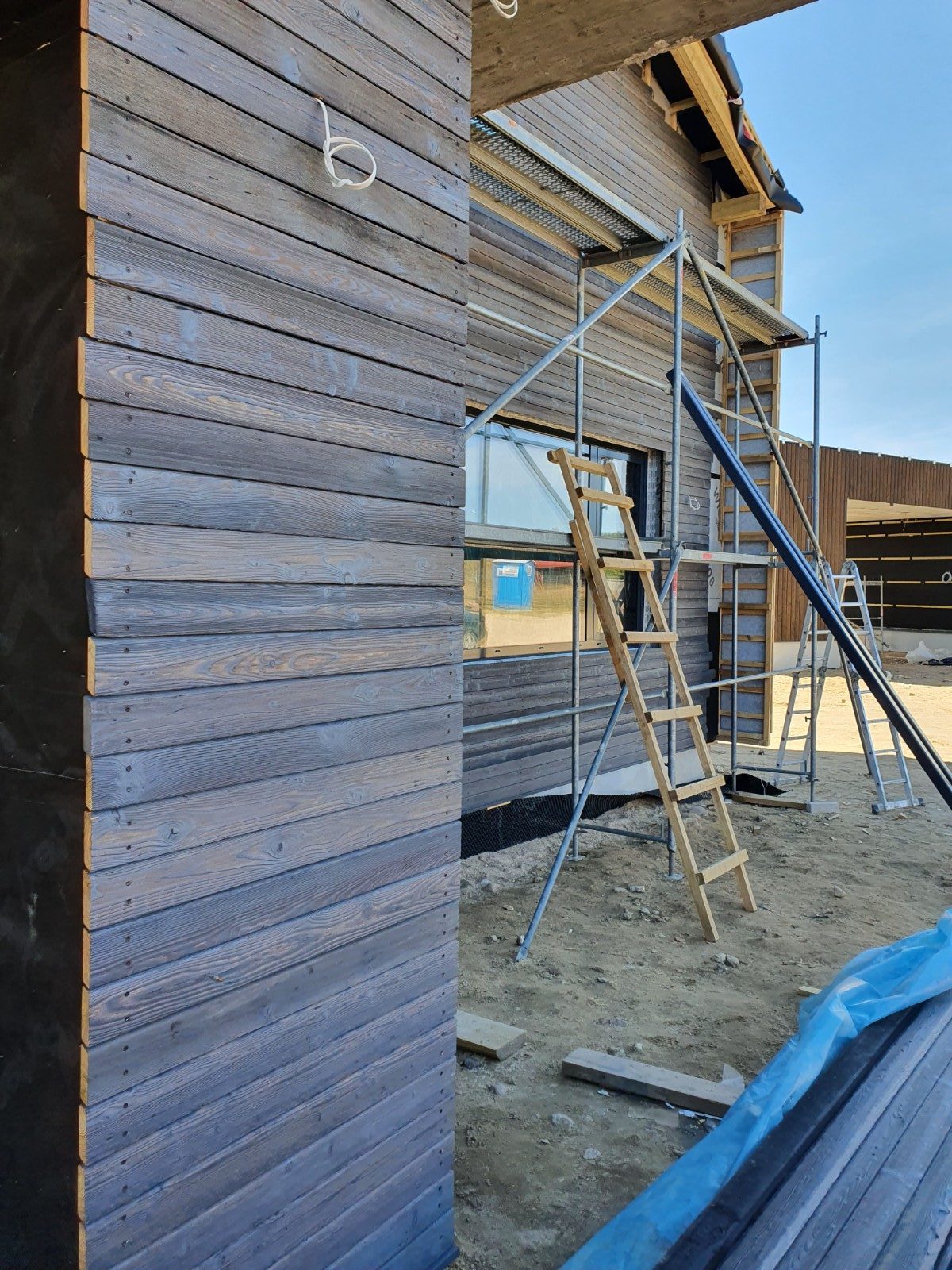
– Burnt wood siding installation.
Pros
Cypress is ideal for wood cladding projects due to its reliability and low maintenance costs. It can stand up to most elements. Rumor even has it that the legendary Noah’s Ark was made of cypress wood! Cypress wood is so durable that it’s been known to last for generations, making it one of the most cost-effective and ideal old wood cladding styles.
Cons
Although cypress lasts long, some of its variations are toxic and can irritate people with certain respiratory diseases, such as asthma. Some have also reported that cypress has an unpleasant odor.
Engineered Wood
Engineered wood, simply put, is manmade lumber. This kind of wood is designed to have the highest durability and strength while still looking like natural wood. Engineered wood can be a composite of different materials, depending on the brand.
Pros
Because it is engineered to be stronger and more durable than natural wood, this modern wood cladding is an excellent option for various climates. It stands up to moisture and is less likely to rot than softer types of wood, while still maintaining softwood styling styles. It also lasts longer than its natural counterpart and is easier to maintain.
Cons
Although engineered wood much resembles natural wood, it is not natural, which might be a drawback to those who are committed to maintaining a completely sustainable lifestyle. The quality of engineered wood can also vary from brand to brand, so it’s important to carefully inspect the material before you buy to ensure you’re getting the highest quality.
Thermowood
Thermowood is a sustainable wood produced naturally by both heat and steam, making it an excellent option for many indoor and outdoor projects.
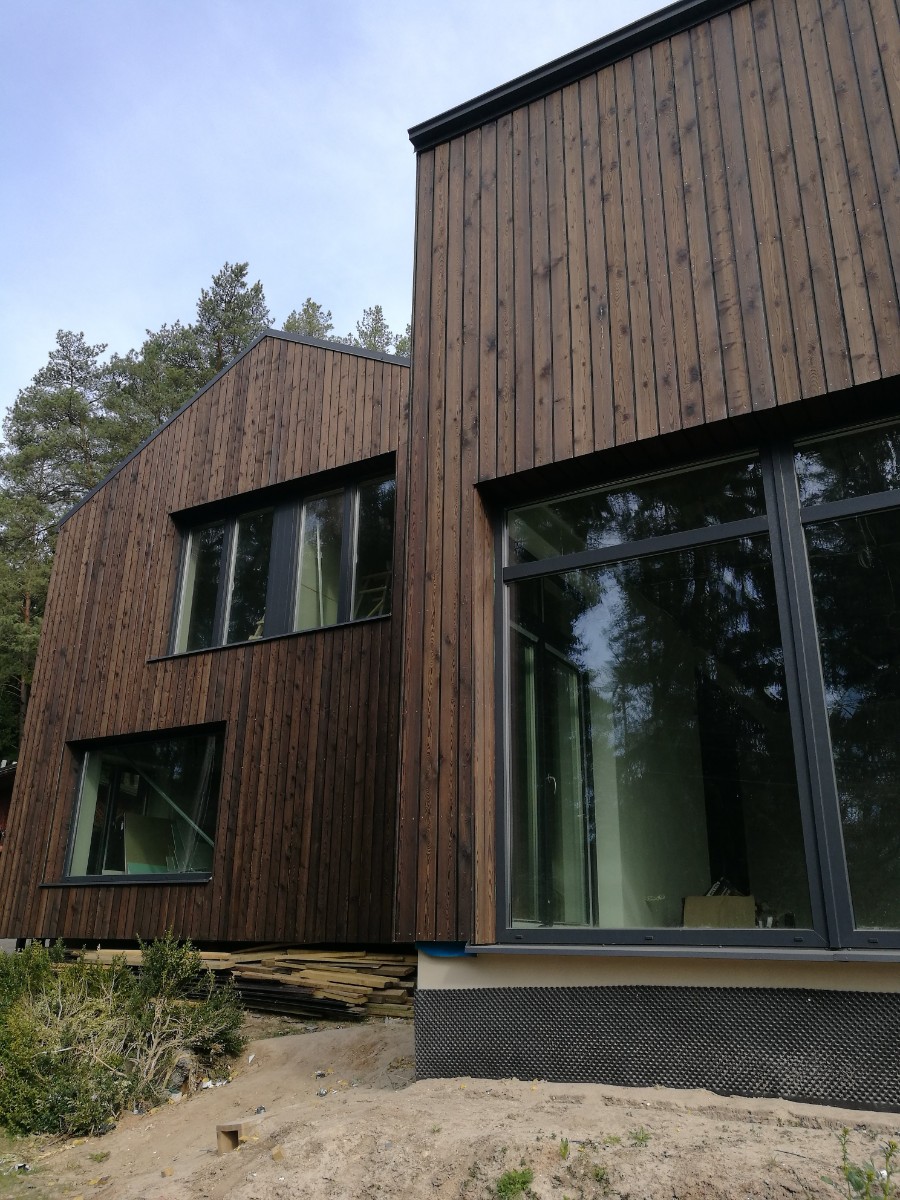
– A beautiful Yakisugi siding house in the woods.
Pros
Thermowood is a very sustainable wood with a beautiful finish, making it perfect for reducing carbon footprint. It’s free of resin, which makes it highly resistant to decay and rot, and non-toxic.
Cons
Because this is a lighter wood, it needs to be sealed and protected to maintain its beautiful exterior. Although the brown timber is known for its rich, lustrous tone, it can weather to a silver-grey color if left untreated.
Cumaru
Although its name is probably not as familiar as pine or spruce, cumaru wood has steadily gained traction with architects for residential and commercial buildings. This timber species finds its origins in Brazil.
Pros
Cumaru is an extremely durable wood that can stand up to any climate elements and lasts for generations. This trait makes it a great cost-effective option for many households looking for a low-maintenance wood cladding to protect their homes from harsh climates. It’s also a completely natural wood product that can be recycled and reused at the end of its life cycle.
Cons
Because cumaru is a dense and heavy wood, it may not be suitable for all projects. Although it is an excellent choice for those in colder climates, its dark color tends to absorb heat, making some homes extremely hot in the summer season.
Douglas Fir
Douglas fir wood is available in warm red and blonde tones, making it a great old wood siding material for a rustic setting or rural environment.

– A small house with dark and light Shou Sugi Ban siding
Pros
The aesthetic of a Douglas fir wood is hard to beat. With a beautiful and vibrant color combined with impressive knots, this wood has a lot of character. Its even tone and fine, straight grain makes it perfect for side cladding to produce an even, polished look. Douglas fir wood has been a popular staple in century-old homes that are still standing today.
Cons
Because of its vibrant color and highly sought after beauty, Douglas fir wood is usually expensive and hard to find. It also requires regular maintenance to maintain its appearance and durability.
Garapa
Garapa wood is a type of Brazilian timber. It is an up and coming wood that provides brilliant modern wood siding due to its durability and superior strength.
Pros
Although it compares with many other types of wood in terms of strength and reliability, Garapa is a fantastic choice for hotter climates. Due to its light color pigment, these wood cladding types can stand up to intensive sun exposure and reflect the heat outwards to prevent the home from becoming overly warm. Like redwoods, it’s also naturally resistant to insects and wood decay.
Cons
Because Garapa is quickly gaining a reputation as one of the highest quality, best natural wood siding materials today, it can be expensive and hard to come by. Some color variations may fade over time when exposed to sunlight, requiring regular maintenance and oil finishing to prolong their original color’s lifespan.
Tatajuba
Tatajuba wood hails from South America and is a popular choice for decks and patios. It is popularly known for its durability and strength.

– Unique house with dark Shou Sugi Ban wood siding.
Pros
Due to its wet climatic origins, Tatjuba wood is resilient to rot, warm weather, and insect damage. Its high density and durability make it an excellent choice for beginners.
Cons
Although it starts as a beautiful golden color, it will quickly turn into a deep, red-brown once exposed to sun and weather, sometimes only a week after installation. It also requires regular maintenance and upkeep to maintain its appearance.
Massaranduba
Nicknamed the “Brazilian Redwood,” Massaranduba provides a beautiful textured appearance unlike any other while also keeping its reputation as one of the world’s hardest and most durable timber species.
Pros
Due to its resistance to rot and decay, Massaranduba is perfect for exterior projects, especially when it comes to wooden siding. This species has a reputation for its longevity. It is also insect-repellant and can stand up to the elements with ease. It’s most known for its beautiful color and vibrant, deep-toned design, making it suitable for any DIY home project.
Cons
Due to its beauty, it is a more expensive option than other kinds of woods and can be harder to maintain. Because of its weight, it is not suitable for some home projects.
Iroko
For those looking for a different wood siding style, this highly sought after timber specie is ideal for wooden cladding due to its durability and beautiful light amber color.
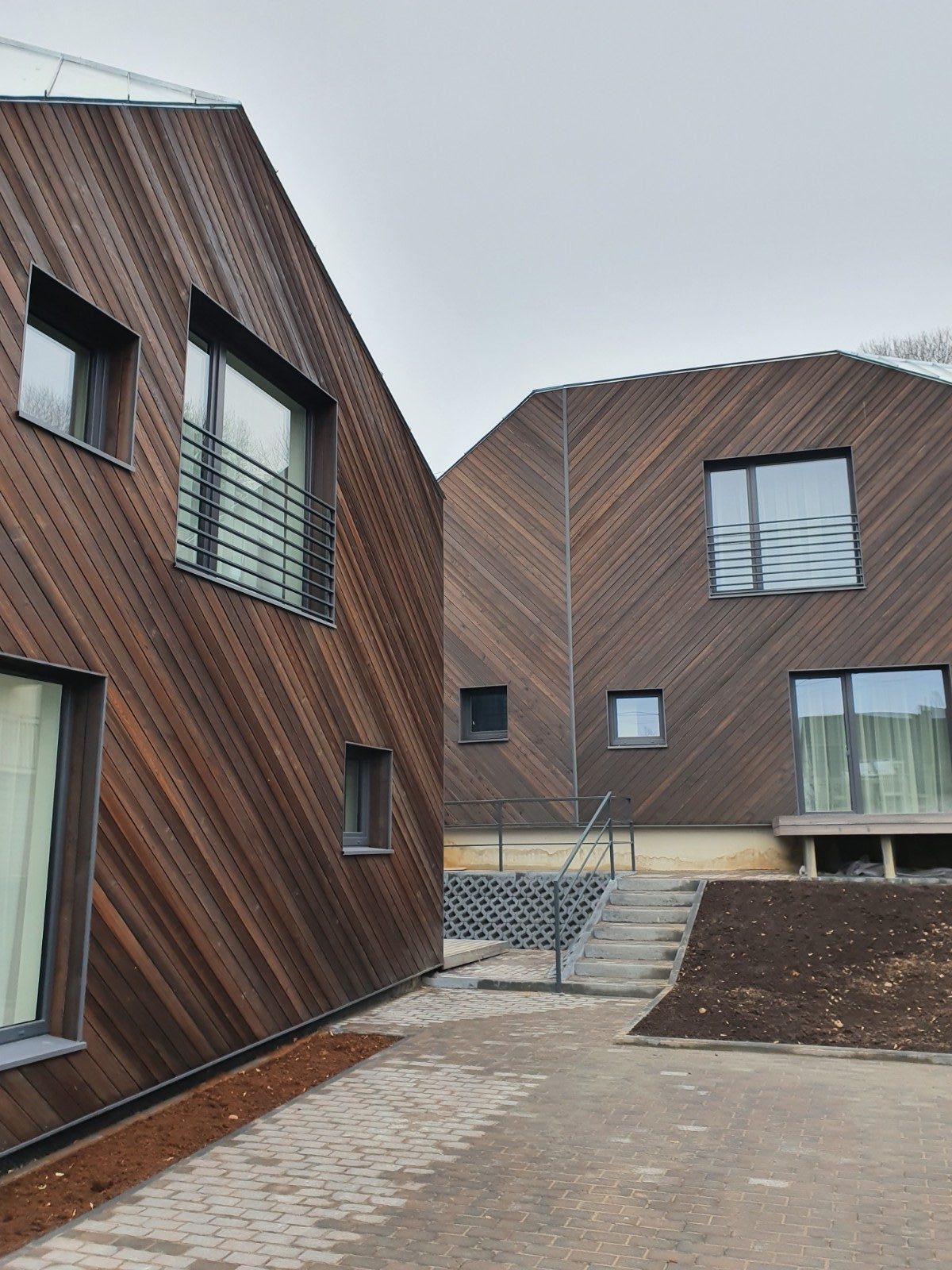
– Two houses with brown charred wood siding.
Pros
Iroko wood is exceptionally uniform with little color variation between boards, giving a sense of elegance to outdoor wood siding. It is naturally insect-resistant and does not decay or rot easily. It is also highly resistant to moisture and is one of the best types of wood to use in warm, wet climates.
Cons
Iroko wood is one of the heaviest woods, which might not be ideal for every home project. Its limited supply also makes it hard to find and expensive to purchase. Its hard and dense nature also can make it challenging to work with.
Your Ultimate Wood Cladding Solution
If you’re looking to purchase different wooden siding styles and don’t know where to turn, don’t fret! Degmeda.eu provides quality charred wood, which is hard to find in most retail stores. They provide burnt wood cladding, flooring, decking, fencing, and a wide variety of materials for any home improvement project! Their catalog comprises some of the popular wood species, such as pine, spruce, and cedar, and includes harder to find timber, like Accoya and Siberian Larch. Don’t hesitate to check out their website for more information.
With worldwide shipping and custom wood charring services, they’re an excellent option for anyone looking to upgrade their home. They also include valuable resources on wood cladding ideas for your home and tips on making your exterior wood siding last longer. If you’re looking to learn more about the best type of wood for your home styling project, get in touch with the Degmeda team. You won’t regret it!